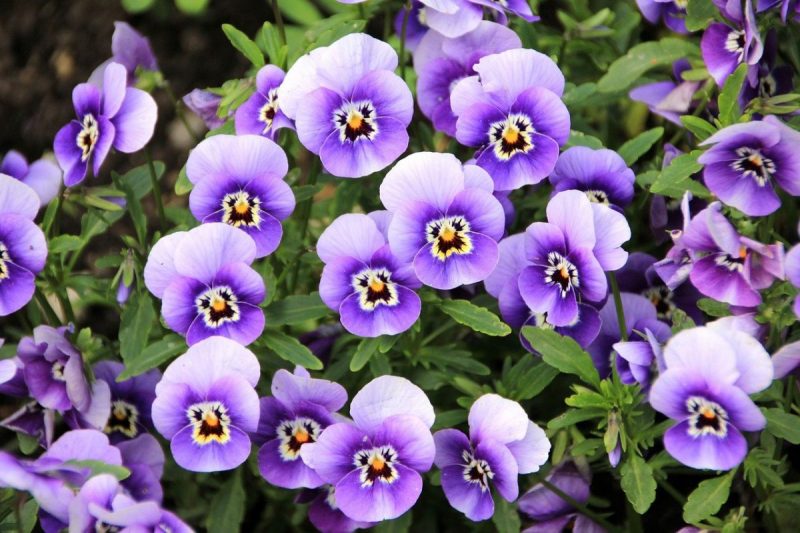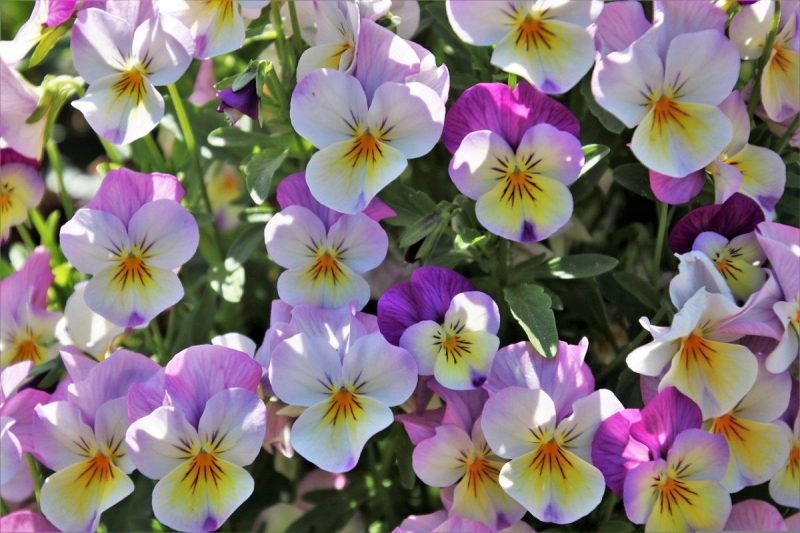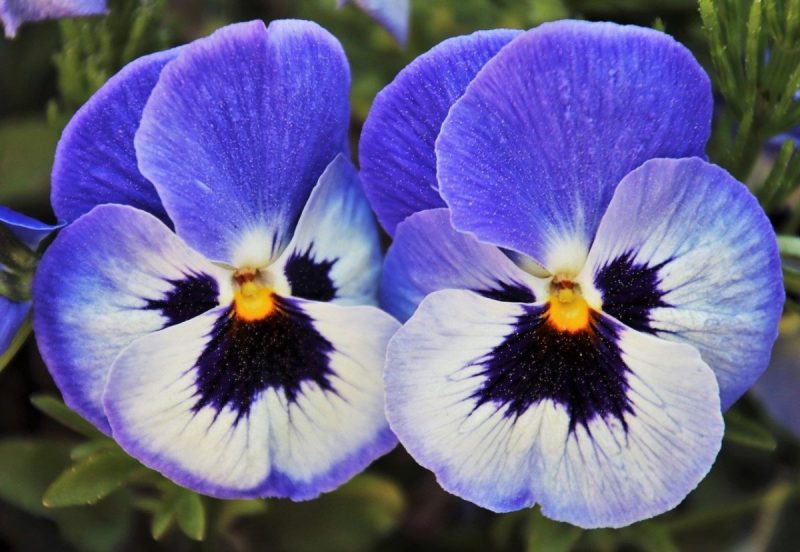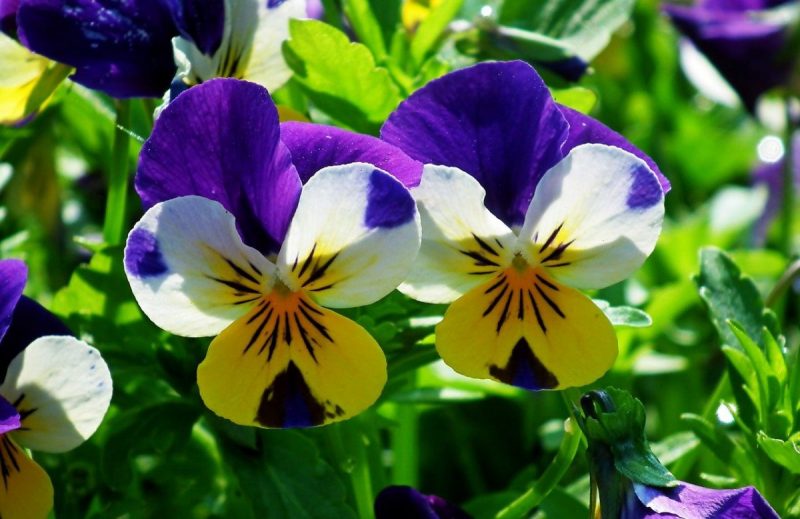Pansies, planting guide and care work

Pansies (Viola x wittrockiana) – are perennial, herbaceous plants, native to Europe and Asia, belonging to the Violaceae family. Although they are normally perennial plants, most often they are grown as annual or biennial plants (in areas with a warmer climate). They can be grown both as plants in flowerpots/containers and in the garden. Pansies have a height of 15-25 cm and are well-branched from the base, the branches being creeping in the lower part and straight, upwards-oriented towards the top.
The leaves are green, glossy, oblong or oval-lanceolate, serrated on the edges. The flowers are arranged axillary and consist of 5 large, unequal petals. They have various colors: unicolor, bicolor, white, yellow, purple, blue. The first flowers appear in autumn, but the abundant flowering occurs in spring (March-June). However, hybrids have been created that can bloom profusely in autumn and varieties that behave as annual plants, blooming in summer (only in areas with moderate temperatures).
Pansies – Varieties
- ‘Jolly Joker’: it blooms in spring and summer. It has orange flowers with dark burgundy upper petals and a purple outline;
- The Princess series features a variety of colors, such as blue, purple and yellow;
- The Fama series blooms in winter (depending on the climate) and spring. It displays a wide variety of single color and mixed color flowers.



Recommended products
-
You can find products on a different store
Change Store -
You can find products on a different store
Change Store -
You can find products on a different store
Change Store -
You can find products on a different store
Change Store -
You can find products on a different store
Change Store -
You can find products on a different store
Change Store -
You can find products on a different store
Change Store -
You can find products on a different store
Change Store -
You can find products on a different store
Change Store -
You can find products on a different store
Change Store -
You can find products on a different store
Change Store -
You can find products on a different store
Change Store -
You can find products on a different store
Change Store -
You can find products on a different store
Change Store -
You can find products on a different store
Change Store -
You can find products on a different store
Change Store -
You can find products on a different store
Change Store -
You can find products on a different store
Change Store -
You can find products on a different store
Change Store -
You can find products on a different store
Change Store -
You can find products on a different store
Change Store -
You can find products on a different store
Change Store -
You can find products on a different store
Change Store -
You can find products on a different store
Change Store
Environmental conditions
Light. Pansies will bloom profusely in sunny or partially shaded places. These will keep their specific aesthetic appearance and will continue to bloom for a longer period of time in partially shaded places.
Soil. Although they do not have high demands in terms of soil/substrate, pansies grow well in fertile, light soils/substrates that allow good water drainage.
Temperature. It does not tolerate high temperatures (strong heat), often declining during the days with high temperatures.
Care
Watering. It prefers damp soils/substrates, and therefore it is recommended that watering should be carried out moderately. In the case of plants grown in flowerpots, it is essential that they have drainage holes, and in the case of plants grown in the garden, the soil should drain water properly.
Fertilizing. To stimulate a healthy growth and abundant flowering, it is recommended to regularly administer fertilizers specially formulated for flowering plants.
Recommended products
-
You can find products on a different store
Change Store -
You can find products on a different store
Change Store -
You can find products on a different store
Change Store -
You can find products on a different store
Change Store -
You can find products on a different store
Change Store -
You can find products on a different store
Change Store -
You can find products on a different store
Change Store -
You can find products on a different store
Change Store -
You can find products on a different store
Change Store -
You can find products on a different store
Change Store -
You can find products on a different store
Change Store -
You can find products on a different store
Change Store -
You can find products on a different store
Change Store -
You can find products on a different store
Change Store -
You can find products on a different store
Change Store -
You can find products on a different store
Change Store -
You can find products on a different store
Change Store -
You can find products on a different store
Change Store -
You can find products on a different store
Change Store -
You can find products on a different store
Change Store -
You can find products on a different store
Change Store -
You can find products on a different store
Change Store -
You can find products on a different store
Change Store -
You can find products on a different store
Change Store
Dormancy. Although some varieties capable of withstanding mild winters have been created, most pansies do not survive the winter. If the dried flowers have not been removed after the flowering period has passed, it is possible that the remaining seeds will germinate in the spring, when the optimal conditions are met.
Propagation. It is done by seeds or stem cuttings (in autumn or spring).
The seeds are sown in boxes and spread on the surface of the substrate (moistened in advance), then lightly pressed and covered with a layer of soil. The optimal temperature for seed germination is approximately 18 °C, and the plants will sprout within 14 days. When the seedlings will have 2 true leaves, they can be transplanted into individual flowerpots. They will be kept in optimal conditions until they can be transplanted outside.
Diseases and pests
Pansies can be affected by various leaf spots, rots, viruses, rusts. As pests, they can most frequently be attacked by aphids, slugs, etc.
Additionally
- They can be grown both in flowerpots/containers and in the garden, often being used as a decorative element for curbs, alleys, roundabouts, etc.;
- After blooming, dry flowers can be cut to stimulate the appearance of other flowers;
- If after blooming the dry flowers are not removed, the seeds will naturally fall to the ground. In areas with a cold climate, there is a possibility that they will germinate and form new plants, but most likely they will not keep the characteristics of the mother plant.















































































































































































































































































































































































































































